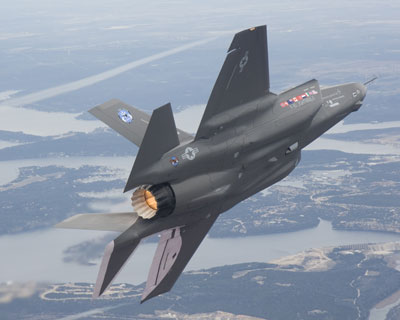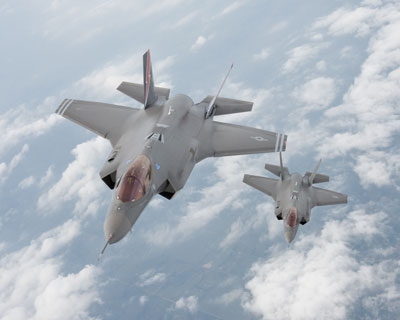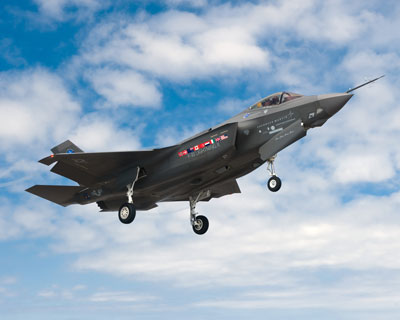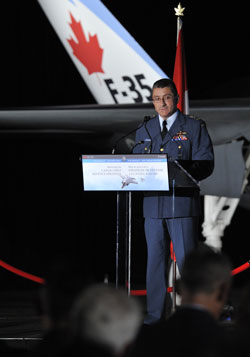 This information has been archived for reference or research purposes.
This information has been archived for reference or research purposes.
Archived Content
Information identified as archived on the Web is for reference, research or recordkeeping purposes. It has not been altered or updated after the date of archiving. Web pages that are archived on the Web are not subject to the Government of Canada Web Standards. As per the Communications Policy of the Government of Canada, you can request alternate formats on the "Contact Us" page.
Views and Opinions

Lockheed Martin photo 3480991144_9271084af_o
Meet the F-35 Lightning II – Canada’s Next Fighter
by Lieutenant-General André Deschamps
For more information on accessing this file, please visit our help page.
On 16 July 2010, the government announced that it was exercising its option under the Joint Strike Fighter (JSF) Program Memorandum of Understanding to acquire the F-35 Lightning II as Canada's next generation fighter. As Commander of Air Command, I am delighted that the Canadian Forces will acquire the Lightning II, and I am fully convinced that this is the right fighter aircraft for Canada.
The F-35 Lightning II is being produced as part of a multi-national initiative to build an affordable, sustainable, multi-role,1 and stealthy fighter aircraft; our eight partners are the United States, the United Kingdom, Italy, Australia, Turkey, Norway, Denmark, and the Netherlands. We are acquiring the conventional take-off and landing variant for our fleet; Lockheed Martin is also producing a short take-off and vertical landing variant and an aircraft carrier variant.
The CF-18 Hornet has provided outstanding service to Canada for more than 28 years, and it will remain our front line fighter until the 2020 timeframe, when it reaches the end of its life expectancy. The first F-35 is slated for delivery in 2016. The timing will allow for phase-in of the Lightning II, ensuring we can re-train our personnel while avoiding a gap in our operational capability.
Why fighters?
Manned fighters are essential to our ability to exercise control and sovereignty over our airspace in Canada, and to conduct operations abroad. This is a fact of modern air power, and all industrialized nations acknowledge it as such. Neither unmanned aerial vehicles nor any other air platform can carry out this demanding and complex task, whether operating in the air-to-air or air-to-surface environments.
In combat, if you do not control the airspace over which you are operating – land or maritime – you will either incur unacceptable losses, or you will fail. You must possess the ability to deny an adversary use of that airspace in order to win. Field Marshal Bernard Montgomery knew this, saying: “If we lose the war in the air, we lose the war and we lose it quickly.” This statement remains as true in today’s post 9/11 security environment as it was during the Second World War. Air superiority is key to success on the battlefield.
Over its lifetime, the CF-18 Hornet has been used in the 1991 Gulf War, the 1999 Kosovo air campaign, Canada’s response to 9/11, and NATO operations. It is also a vital part of Canada’s daily NORAD continental defence operations. In this year alone, CF-18s and their crews provided security for the Vancouver 2010 Olympic and Paralympic Games and the G8/G20 Summits in Ontario, and also conducted numerous sovereignty flights. In May, Canadian CF-18s intercepted a civilian airliner after information was received about a potential threat associated with it. The CF-18s, operating as part of NORAD, escorted the aircraft until it landed safely in Vancouver.

Lockheed Martin photo 4618110379_f7i67651eb_o
What are our future threats and missions?
Following the announcement of the government’s intent to acquire a next generation fighter in the Canada First Defence Strategy, we examined requirements for our new fighters very closely, and then finalized them in early 2010. We looked at future and current roles and missions that our next generation fighter capability would be responsible for, and the environment – both physical and military threat – in which it would be operating.
What constitutes a 5th generation fighter?
Three key capabilities distinguish a 5th generation fighter from a 4th generation fighter:
Interoperability: a unique combination of stealth, long-range high resolution sensors, a comprehensive self-defence suite, and secure high-capacity networks that allow aircraft to communicate with one another and share data in a secure environment.
Sensors/data fusion: a system that consolidates tactical information from the sensors and off-board sources to provide pilots with a clear understanding of the tactical situation at a glance.
Survivability: very low observable stealth, advanced sensors and secure data-link that mean a 5th generation aircraft can accomplish more in a mission with fewer supporting assets.
Furthermore: 4th generation aircraft cannot be upgraded to a 5th generation aircraft.
We need a capability that helps us carry out our core missions of defending the sovereignty of Canadian and North American airspace through NORAD, providing Canada with an effective and modern capability for international operations, and effectively conducting joint operations with our Allies through NATO or a coalition force. We need robust aircraft, capable of operating across Canada's vast geography and under harsh and varying weather conditions and deterring challenges to Canadian sovereignty. Our fighter aircraft must be capable of undertaking multiple roles, and flexible enough to deal with threats and missions that were unexpected at the time of its conception. We know that some of the threats faced by the CF-18 in the late 20th Century have faded, some have continued, and new ones have emerged. There is no reason for us to doubt that we will continue to see similar fluidity and evolution in threats as this century unfolds.
Why 5th generation?
Our analysis of our mandatory requirements for the next generation fighter made it clear that only a 5th generation fighter could satisfy those requirements in the increasingly complex and uncertain future security environment.
Specifically, a 5th generation aircraft satisfied five key mandatory requirements:
- stealth capabilities;
- secure communications;
- capability for the pilot to visually operate the aircraft in no-light conditions (night vision goggles are ineffective in no-light conditions);
- automatic sharing of data and sensor information between friendly aircraft to maximize the effectiveness of the pilot’s own and formation aircraft; and
- capability for the pilot to effectively detect and engage small targets at tactically significant ranges.
The F-35 Lightning II is revolutionarily different in terms of capability, and it brings unique advantages:
- Stealth technology – low observability – will significantly reduce the aircraft’s electromagnetic signature and therefore reduce detection by enemy sensor systems. It provides lower risk and improved survivability for the pilot as well as enhanced intelligence, surveillance, and reconnaissance (ISR) capabilities.
- Advanced sensor and data fusion technology will gather, synthesize, and display information to help pilots understand the tactical situation at a glance, make complex tactical decisions quickly, and take decisive action. The aircraft takes care of much of the data gathering and synthesis that pilots now have to do themselves, and which has become almost overwhelming in terms of quantity and speed. In effect, the aircraft is the co-pilot.
- Interoperability with our partners/allies that will be seamless, safe and effective within NORAD and NATO, and on coalition operations. The F-35 allows us to share the entire situational awareness that the aircraft ‘sees’ with partner aircraft. When we go into operations abroad with a coalition of like-minded nations with the same platform, the aircraft are the same. Therefore, we can share resources and we can quickly go into an operation without weeks of training because we have the same equipment and software as our partners. It makes a big difference in how we are going to do business as a coalition.
- The aircraft is sustainable. We will be able to replace lost aircraft – or acquire additional aircraft if the future global situation demands it – because the production line will operate until at least 2035. Software will be upgraded on an ongoing basis, and we will not have to contract individually for upgrades, accruing huge savings, and keeping the aircraft up to date as technology evolves.
And then there are the concerns about a single-engine aircraft … I want to assure you that engine safety and performance have improved greatly compared to that of previous aircraft generations, thanks to superior ingestion and damage tolerance, fault detection and prognostics, redundancy, and electronic controls. As a result, modern single- and twin-engine fighter aircraft have virtually equivalent engine-related attrition rates from either engine failure or combat damage. There are, however, significantly lower operating and maintenance costs associated with a single engine configuration.
What about a competition?
Canada joined the JSF Program in 1997. Since then, we have, along with the other partner nations, been consistently consulted on a wide range of program activities and issues – including the rigorous competition between Boeing and Lockheed Martin that resulted in Lockheed Martin being selected to produce the JSF in 2001.2
The F-35 Lightning II is the only aircraft that meets our mandatory requirements and the only 5th generation aircraft available to Canada. The only other 5th generation fighter, the F-22 Raptor, is an excellent air superiority fighter that is being upgraded through the addition of selected capabilities that have their origin in the F-35, but the US government does not permit foreign sales of it.

Lockheed Martin photo 3480183277_a8548ac884_o
Are the costs too high?
The F-35 Lightning II also offers best value of any fighter available to Canada. The acquisition itself will cost $9 billion. However, this represents the cost of the 65 individual aircraft as well as contingency funding for currency escalation, plus program costs, integrated logistics support, weapons, infrastructure, simulation and so on – all of which would be intrinsic costs to any modern fighter acquisition. We estimate the cost per aircraft to be in the low-to-mid-US$70 million range. We will be purchasing our aircraft – which is the most cost-effective variant of the Lightning II – between 2016 and 2022, which will be the peak point of production, and therefore, when costs are projected to be at their lowest. In fact, in 2016 dollars, the per-aircraft cost of buying the F-35 is only slightly more than the per-aircraft cost paid for the CF-18 Hornet in the 1980s.
Overall, this is the single largest fighter aircraft program in history. Being part of a partnership that will produce 3000 aircraft – plus an estimated 2000 or more aircraft in export sales to non-partner nations – represents an economy of scale unprecedented in fighter production.
In terms of sustainment, costs will be about the same as our current fleet of CF-18s – or any modern fighter. We are also working with JSF partners to identify ways of cooperating on sustainment issues, which promises even greater efficiencies.
How will Canadian industry benefit?
Canadian companies will have an opportunity to provide products and services for the entire global JSF supply chain. Considering that this will apply to as many as 5000 aircraft, herein rests huge opportunities for the aerospace industry in Canada over the operational lifetime of the F-35. It is estimated that more than $12 billion in potential industrial opportunities exist for Canadian companies to deliver the F-35 to our partners. Furthermore, acquisition by other nations will result in further benefits for Canadian companies.
To date, Canada has invested $168 million in the JSF Program. Since 2002, our participation has led to more than $350 million in contracts for Canadian companies, research laboratories and universities.
And in summary …
Given the increasingly complex and uncertain future security environment, the F-35 Lightning II will provide Canada with the greatest probability of mission success and the greatest probability that our men and women will survive and return safely from their missions.
We are acquiring the F-35 Lightning II to protect Canadian interests, and to counter tomorrow’s threats. Procured and sustained through the JSF Program, the F-35 is the best value for our taxpayer dollar, and will keep Canada at the forefront of fighter operations – enabling our fleet to remain relevant, flexible, viable, and sustainable well into the middle of this century.

DND photo FA2010-0218-18
![]()
Lieutenant-General André Deschamps, CMM, CD, is the current Chief of the Air Staff and Commander of Air Command, as well as a former fighter pilot.
Notes
- That is, capable of carrying out a variety of air-to-air and air-to-surface combat roles.
- I refer you to the Public Broadcasting Service’s documentary, ‘Battle of the X-Planes, ’ that first aired in 2003 (www.pbs.org/wgbh/nova/xplanes), as well as the Joint Strike Fighter website (www.jsf.mil/history) for accounts of the competition between Lockheed Martin and Boeing.






